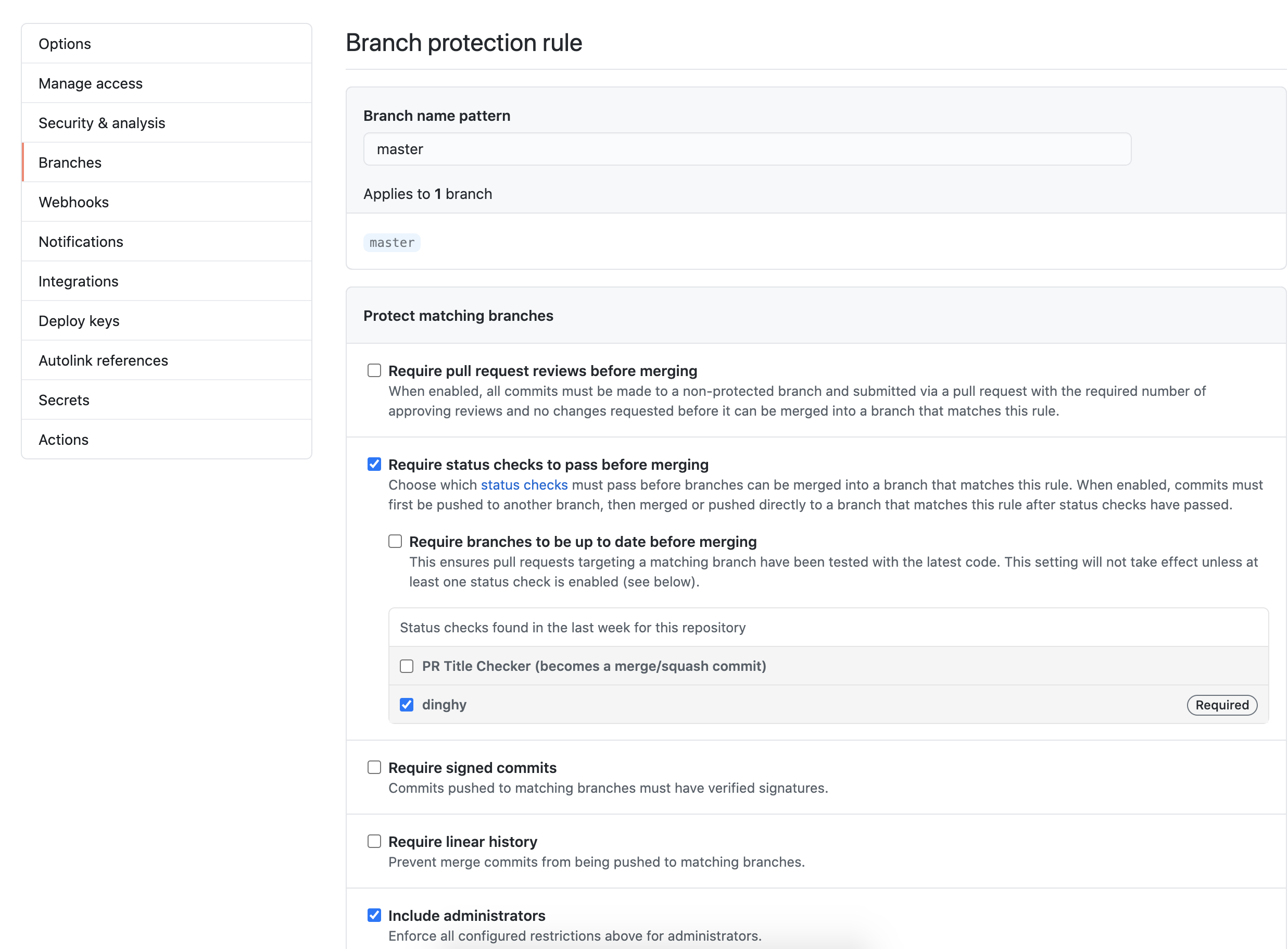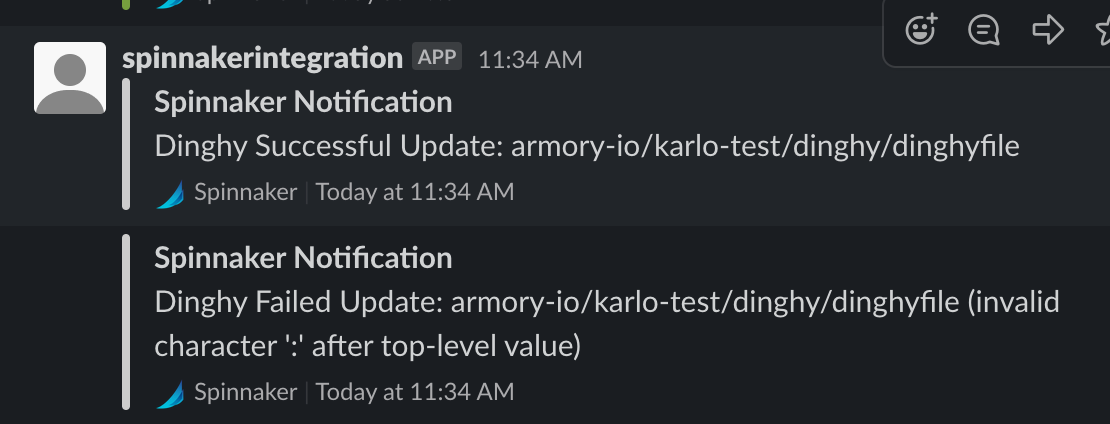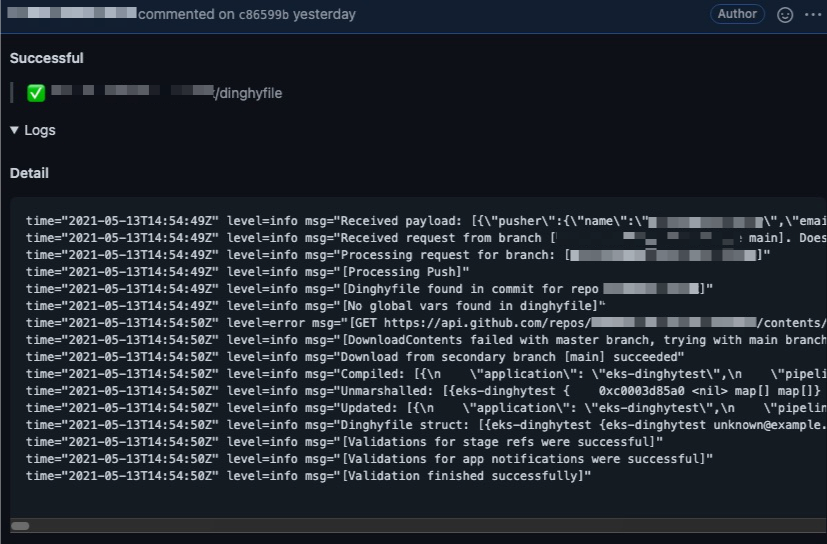Enable Pipelines as Code in Armory Enterprise
Advantages to using Pipelines as Code
Armory’s Pipelines as Code feature provides a way to specify pipeline definitions in source code repos such as GitHub and BitBucket.
The Armory installation provides a service called Dinghy, which keeps the pipeline in sync with what is defined in the GitHub repo. Also, users are able to make a pipeline by composing other pipelines, stages, or tasks and templating certain values.
GitHub is in the process of replacing
masteras the name of the default base branch. Newly created repos usemain. As this transition happens, confirm what branch your repo is using as its base branch and explicitly refer to that branch when configuring Armory features such as Pipelines as Code. For more information, see Renaming.
This guide includes:
- Configurations for enabling Armory’s Pipelines as Code feature using Armory Operator or Halyard
- Settings for GitHub, GitLab, or Bitbucket/Stash webhooks to work with the Pipelines as code
- GitHub custom branch configuration for information about how to explicitly set the branch that Pipelines as Code uses.
Enabling Pipelines as Code
Dinghy is the microservice for Pipelines as Code. You need to enable it to use Pipelines as Code.
In SpinnakerService manifest:
apiVersion: spinnaker.armory.io/v1alpha2
kind: SpinnakerService
metadata:
name: spinnaker
spec:
spinnakerConfig:
config:
armory:
dinghy:
enabled: true # Whether or not Dinghy is enabled
... # Rest of config omitted for brevity
Assuming Spinnaker lives in the spinnaker namespace:
kubectl -n spinnaker apply -f spinnakerservice.yml
hal armory dinghy enable
Configuring SQL
Early Access
The information below is written for an Early Access feature. Contact us if you are interested in using this feature! Your feedback will help shape the development of this feature.Do not use Early Access features for production environments.
The Dinghy service can use MySQL to store relationships between pipeline templates and pipeline Dinghy files. An external MySQL instance is highly recommended for production use because it can provide more durability for Pipelines as Code. If MySQL becomes unavailable, Dinghy files will need to be updated in order to repopulate MySQL with the relationships.
In SpinnakerService manifest:
apiVersion: spinnaker.armory.io/v1alpha2
kind: SpinnakerService
metadata:
name: spinnaker
spec:
spinnakerConfig:
profiles:
dinghy:
sql:
baseUrl: mysql:3306
databaseName: dinghy
enabled: true
password: password
user: user
kubectl -n spinnaker apply -f spinnakerservice.yml
Edit the ~/.hal/default/profiles/dinghy-local.yml file and add the following:
sql:
user: root
password: password
baseUrl: mysql-url:3306
databaseName: dinghy
enabled: true
Migration from Redis to SQL
There’s a migration strategy to move the relationships from Redis to SQL. In order to do that, you need to have the configuration from your redis and add the configuration for SQL as shown previously, when you do this and the pod starts, what will happen is that the migration will be done automatically by a job. To verify that the migration was done successfully you can enter into your database and query this tables.
select * from executions;
select * from fileurls;
select * from fileurl_childs;
In executions table you should be able to see one record with the name REDIS_TO_SQL_MIGRATION.
In fileurls and fileurl_childs you should be able to see the migration information with the Dinghyfiles, modules and their relationships.
After Dinghy makes the migration at start, it will close the Redis connection and it will work in full SQL mode.
Configuring Redis
Dinghy can use Redis to store relationships between pipeline templates and pipeline Dinghy files. An external Redis instance is highly recommended for production use. If Redis becomes unavailable, Dinghy files will need to be updated in order to repopulate Redis with the relationships.
Dinghy can only be configured to use a password with the default Redis user.
To set/override the Spinnaker Redis settings do the following:
In SpinnakerService manifest:
apiVersion: spinnaker.armory.io/v1alpha2
kind: SpinnakerService
metadata:
name: spinnaker
spec:
spinnakerConfig:
profiles:
dinghy:
redis:
baseUrl: "redis://spin-redis:6379"
password: "password"
kubectl -n spinnaker apply -f spinnakerservice.yml
Edit the ~/.hal/default/profiles/dinghy-local.yml file and add the following:
redis:
baseUrl: "redis://spin-redis:6379"
password: "password"
Then run hal deploy apply to deploy the changes.
Configuring Pipelines as Code
- Create a personal access token (in either GitHub or Bitbucket/Stash) that has read access to all repos where you store your
dinghyfileandmodulefiles. - Get your GitHub, GitLab, or Bitbucket/Stash organization where the app repos and templates reside. For example, if your repo is
armory-io/dinghy-templates, yourtemplate-orgwould bearmory-io. - Get the name of the repo containing modules. . For example, if your repo is
armory-io/dinghy-templates, yourtemplate-repowould bedinghy-templates.
GitHub
apiVersion: spinnaker.armory.io/v1alpha2
kind: SpinnakerService
metadata:
name: spinnaker
spec:
spinnakerConfig:
config:
armory:
dinghy:
enabled: true # Whether or not Dinghy is enabled
templateOrg: my-org # SCM organization or namespace where application and template repositories are located
templateRepo: dinghy-templates # SCM repository where module templates are located
githubToken: abc # GitHub token. This field supports "encrypted" field references (https://docs.armory.io/spinnaker-install-admin-guides/secrets/)
githubEndpoint: https://api.github.com # (Default: https://api.github.com) GitHub API endpoint. Useful if you’re using GitHub Enterprise
... # Rest of config omitted for brevity
kubectl -n spinnaker apply -f spinnakerservice.yml
hal armory dinghy edit \
--template-org "armory-io" \
--template-repo "dinghy-templates" \
--github-token "your_token/password"
# For GitHub enterprise, you may customize the endpoint:
--github-endpoint "https://your-endpoint-here.com/api/v3" # (Default: https://api.github.com) GitHub API endpoint. Useful if you’re using GitHub Enterprise
hal deploy apply
Configuring GitHub webhooks
Set up webhooks at the organization level for Push events. You can do this by going to https://github.com/organizations/<your_org_here>/settings/hooks.
-
Set
content-typetoapplication/json. -
Set the
Payload URLto your Gate URL. Depending on whether you configured Gate to use its own DNS name or a path on the same DNS name as Deck, the URL follows one of the following formats:https://<your-gate-url>/webhooks/git/githubif you have a separate DNS name or port for Gatehttps://<your-spinnaker-url>/api/v1/webhooks/git/githubif you’re using a different path for Gate
If your gate endpoint is protected by a firewall, you need to configure your firewall to allow inbound webhooks from GitHub’s IP addresses. You can find the IPs in this API response. Read more about GitHub’s IP addresses.
You can configure webhooks on multiple GitHub organizations or repositories to send events to Dinghy. Only a single repository from one organization can be the shared template repository in Dinghy. However, pipelines can be processed from multiple GitHub organizations. You want to ensure the GitHub token configured for Dinghy has permission for all the organizations involved.
Pull request validations
New feature
Pull Request Validation is a new feature in Armory 2.21.When you make a GitHub Pull Request (PR) and there is a change in a dinghyfile, Pipelines as Code automatically performs a validation for that dinghyfile. It also updates the GitHub status accordingly. If the validation fails, you see an unsuccessful dinghy check.

Make PR Validations mandatory to ensure users only merge working dinghyfiles.
Perform the following steps to configure mandatory PR validation:
- Go to your GitHub repository.
- Click on Settings > Branches.
- In Branch protection rules, select Add rule.
- Add
masterin Branch name pattern so that the rule gets enforced on themasterbranch. Note that if this is a new repository with no commits, the “dinghy” option does not appear. You must first create adinghyfilein any branch. - Select Require status checks to pass before merging and make dinghy required. Select Include administrators as well so that all PRs get validated, regardless of user.
The following screenshot shows what your GitHub settings should resemble:

Bitbucket Server (Stash) and Bitbucket Cloud
Bitbucket has both cloud and server offerings. See the Atlassian docs for more on the name change from Stash to Bitbucket Server. Consult your company’s Bitbucket support desk if you need help determining what flavor and version of Bitbucket you are using.
apiVersion: spinnaker.armory.io/v1alpha2
kind: SpinnakerService
metadata:
name: spinnaker
spec:
spinnakerConfig:
config:
armory:
dinghy:
enabled: true # Whether or not Dinghy is enabled
templateOrg: my-org # SCM organization or namespace where application and template repositories are located
templateRepo: dinghy-templates # SCM repository where module templates are located
stashUsername: stash_user # Stash username
stashToken: abc # Stash token. This field supports "encrypted" field references (https://docs.armory.io/spinnaker-install-admin-guides/secrets/)
stashEndpoint: https://my-endpoint # Stash API endpoint. If you're using Bitbucket Server, update the endpoint to include the api e.g. https://your-endpoint-here.com/rest/api/1.0
... # Rest of config omitted for brevity
kubectl -n spinnaker apply -f spinnakerservice.yml
hal armory dinghy edit \
--template-org "armory-io" \
--template-repo "dinghy-templates" \
--stash-token "your_token/password" \
--stash-username "stash_user" \
--stash-endpoint "https://your-endpoint-here.com"
hal deploy apply
If you’re using Bitbucket Server, update the endpoint to include the api, e.g.
--stash-endpoint https://your-endpoint-here.com/rest/api/1.0
You need to set up webhooks for each project that has the dinghyfile or module separately. Make the webhook POST to: https://spinnaker.your-company.com:8084/webhooks/git/bitbucket. If you’re using stash <v3.11.6, you need to install the webhook plugin to be able to set up webhooks.
GitLab
apiVersion: spinnaker.armory.io/v1alpha2
kind: SpinnakerService
metadata:
name: spinnaker
spec:
spinnakerConfig:
config:
armory:
dinghy:
enabled: true # Whether or not Dinghy is enabled
templateOrg: my-org # SCM organization or namespace where application and template repositories are located
templateRepo: dinghy-templates # SCM repository where module templates are located
gitlabToken: abc # GitLab token. This field supports "encrypted" field references (https://docs.armory.io/spinnaker-install-admin-guides/secrets/)
gitlabEndpoint: https://my-endpoint # GitLab endpoint
... # Rest of config omitted for brevity
kubectl -n spinnaker apply -f spinnakerservice.yml
GitLab with Pipelines as Code requires Halyard 1.7.2 or later.
hal armory dinghy edit \
--template-org "armory-io" \
--template-repo "dinghy-templates" \
--gitlab-token "your_token/password"
--gitlab-endpoint "https://your-endpoint-here.com"
hal deploy apply
Under “Settings -> Integrations” on your project page, point your webhooks
to https://<your-gate-url>/webhooks/git/gitlab. Make sure the server your
GitLab install is running on can connect to your Gate URL. Armory also needs
to communicate with your GitLab installation. Ensure that connectivity works as well.
Custom branch configuration
Configuring a custom branch is required if you are using a repo that does not use
masteras the base branch. Newly created GitHub repositories that usemainas the default base branch must configure a custom branch using therepoConfigparameter.
By default, Dinghy will use the master branch in your repository. If you wish to use a different base branch for your repository, this can be configured using the repoConfig tag in your yaml configuration.
The repoConfig tag supports a collection of the following values. Each node in the collection must contain all of the fields listed below.
branch- the name of the branch you wish to useprovider- the name of the provider (see below for available providers)repo- the name of the repository
All providers available in Dinghy are supported. Please refer to the list below for the proper name to use in the configuration for each provider.
githubbitbucket-cloudbitbucket-server
apiVersion: spinnaker.armory.io/v1alpha2
kind: SpinnakerService
metadata:
name: spinnaker
spec:
spinnakerConfig:
profiles:
dinghy:
repoConfig:
- branch: some_branch
provider: bitbucket-server
repo: my-bitbucket-repository
- branch: some_branch
provider: github
repo: my-github-repository
... # Rest of config omitted for brevity
This configuration goes inside your profiles/dinghy-local.yml file:
repoConfig:
- branch: some_branch
provider: bitbucket-server
repo: my-bitbucket-repository
- branch: some_branch
provider: github
repo: my-github-repository
Other Options
Fiat
If Fiat is enabled, add the field fiatUser: "your-service-account" to the dinghy section in SpinnakerService manifest (Operator) or pass the option --fiat-user "your-service-account" (Halyard). Note that the service account has to be in a group that has read/write access to the pipelines you will be updating.
If you have app specific permissions configured in Spinnaker, make sure you add the service account. For information on how to create a service account, click here.
Custom Filename
If you want to change the name of the file that describes pipelines, add the field dinghyFilename: "your-name-here" to the dinghy section in SpinnakerService manifest (Operator) or pass the option: --dinghyfile-name "your-name-here" (Halyard).
Disabling Locks
If you want to disable lock pipelines in the UI before overwriting changes, add the field autoLockPipelines: false to SpinnakerService manifest (Operator) or pass the option: --autolock-pipelines false (Halyard).
Slack Notifications
If you configured Armory to send Slack notifications for pipeline events, you can configure Dinghy to send pipeline update results to Slack.
apiVersion: spinnaker.armory.io/v1alpha2
kind: SpinnakerService
metadata:
name: spinnaker
spec:
spinnakerConfig:
config:
armory:
dinghy:
enabled: true
notifiers:
slack:
enabled: true # Whether or not Slack notifications are enabled for dinghy events
channel: my-channel # Slack channel where notifications will be sent to
... # Rest of config omitted for brevity
$ hal armory dinghy slack enable --channel my-channel
For a complete listing of options check out the Armory Halyard documentation.

GitHub Notifications
New feature
GitHub Notifications is a new feature in Armory 2.24.As a new feature in Armory’s release of 2.24.x+, Dinghy can now provide more robust information to GitHub about executed pipeline changes. This information appears as a comment in the PR.
Currently, as of 2.24.1 and 2.25.0, GitHub notifications are not supported with custom endpoints and should be disabled. See the KB article Dinghy Crashing for Customers using 2.24+ when customers are using a Custom Endpoint for details.
apiVersion: spinnaker.armory.io/v1alpha2
kind: SpinnakerService
metadata:
name: spinnaker
spec:
spinnakerConfig:
config:
armory:
dinghy:
enabled: true
notifiers:
github:
enabled: true # Whether or not github notifications are enabled for Dinghy events
In your hal config profiles directory e.g. (~/.hal/default/profiles/), update the dinghy-local.yml file to include the following:
notifiers:
github:
enabled: true

Other Template Formats
This feature requires Armory 2.5.4 or above.
Dinghy supports two additional template formats in addition to JSON:
Selecting one of these parsers means that all of your templates must also be in that format.
You need to configure parserFormat with one of the parsers:
json(Default)yamlhcl
apiVersion: spinnaker.armory.io/v1alpha2
kind: SpinnakerService
metadata:
name: spinnaker
spec:
spinnakerConfig:
profiles:
dinghy:
parserFormat: hcl
... # Rest of config omitted for brevity
Add the following config to ~/.hal/default/profiles/dinghy-local.yml:
parserFormat: hcl
Known Issues
If Dinghy crashes on start up and you encounter an error in Dinghy similar to:
time="2020-03-06T22:35:54Z"
level=fatal
msg="failed to load configuration: 1 error(s) decoding:\n\n* 'Logging.Level' expected type 'string', got unconvertible type 'map[string]interface {}'"
You probably configured global logging levels with spinnaker-local.yml. The work around is to override Dinghy’s logging levels:
apiVersion: spinnaker.armory.io/v1alpha2
kind: SpinnakerService
metadata:
name: spinnaker
spec:
spinnakerConfig:
profiles:
dinghy:
Logging:
Level: INFO
... # Rest of config omitted for brevity
Create .hal/default/profiles/dinghy-local.yml with the following config:
Logging:
Level: INFO
Feedback
Was this page helpful?
Thank you for letting us know!
Sorry to hear that. Please tell us how we can improve.
Last modified May 17, 2021: (d7d072b)
